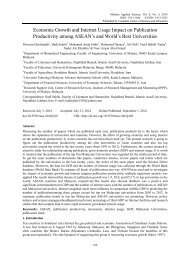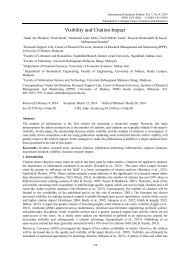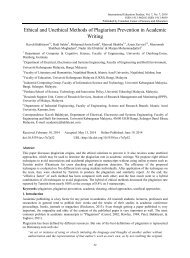Critical factors for new product developments in SMEs virtual team
Create successful ePaper yourself
Turn your PDF publications into a flip-book with our unique Google optimized e-Paper software.
2248 Afr. J. Bus. Manage.<br />
Shah, 2009). Consequently, companies f<strong>in</strong>d that the<br />
<strong>in</strong>ternal development of all technologies necessary <strong>for</strong><br />
<strong>new</strong> <strong>product</strong>s and processes are difficult or impossible.<br />
They must <strong>in</strong>creas<strong>in</strong>gly acquire technology from external<br />
sources (Stock and Tatikonda, 2004). Virtualization <strong>in</strong><br />
NDP has recently begun to make serious progress due to<br />
<strong>developments</strong> <strong>in</strong> technology-<strong>virtual</strong>ity <strong>in</strong> NPD now is<br />
technically possible (Leenders et al., 2003). Virtual NPD<br />
<strong>in</strong> <strong>SMEs</strong> is <strong>in</strong> its <strong>in</strong>fancy <strong>in</strong> develop<strong>in</strong>g countries, and little<br />
research has been done on the <strong>in</strong>troduction of the NPD <strong>in</strong><br />
<strong>SMEs</strong> through a <strong>virtual</strong> <strong>team</strong>. So, we <strong>for</strong>med the topic<br />
that is somewhat lack<strong>in</strong>g <strong>in</strong> the literature as a research<br />
gap.<br />
The ma<strong>in</strong> objective of this paper is to present a model<br />
of critical <strong>factors</strong> of NPD <strong>in</strong> small and medium enterprises<br />
<strong>in</strong> develop<strong>in</strong>g countries. The rest of the paper is<br />
organized as follows:<br />
The ma<strong>in</strong> concepts of <strong>new</strong> <strong>product</strong> development; reviews<br />
recent study on the relationship between NPD and<br />
<strong>virtual</strong>ity; explores the importance of <strong>SMEs</strong>; presents the<br />
relationship between <strong>SMEs</strong> and <strong>virtual</strong> <strong>team</strong>; describes<br />
the research methodology; presents data collection, data<br />
analysis and discussion; and f<strong>in</strong>ally, it concludes the<br />
paper with some perspectives.<br />
WHAT IS NEW PRODUCT DEVELOPMENT (NPD)?<br />
The literature provided a number of def<strong>in</strong>itions <strong>for</strong> what<br />
constitute a <strong>new</strong> <strong>product</strong> development (NPD). Product<br />
development def<strong>in</strong>ition is used by different researchers <strong>in</strong><br />
slightly different ways (Ale Ebrahim et al., 2009b).<br />
Generally, it is the process that covers <strong>product</strong> design,<br />
pro-duction system design, <strong>product</strong> <strong>in</strong>troduction<br />
processes and start of <strong>product</strong>ion (Johansen, 2005).<br />
Loch and Kavadias (2008) <strong>in</strong> the “Handbook of New<br />
Product Development Management” def<strong>in</strong>e NPD to<br />
“consists of the activities of the firm that lead to a stream<br />
of <strong>new</strong> or changed <strong>product</strong> market offer<strong>in</strong>gs over time.<br />
This <strong>in</strong>cludes the generation of opportunities, their<br />
selection and trans<strong>for</strong>mation <strong>in</strong>to artifacts (manufactured<br />
<strong>product</strong>s) and activities (services) offered to customers<br />
and the <strong>in</strong>stitutionalization of improvements <strong>in</strong> the NPD<br />
activities themselves”. Accord<strong>in</strong>g to the <strong>product</strong><br />
development and management association (PDMA)<br />
glossary <strong>for</strong> <strong>new</strong> <strong>product</strong> development <strong>in</strong> the PDMA tool<br />
book 3 <strong>for</strong> <strong>new</strong> <strong>product</strong> development (Griff<strong>in</strong> and<br />
Somermeyer, 2007), NPD was def<strong>in</strong>ed as “the overall<br />
process of strategy, organization, concept generation,<br />
<strong>product</strong> and market<strong>in</strong>g plan creation and evaluation, and<br />
commercialization of a <strong>new</strong> <strong>product</strong>. Also, it is frequently<br />
referred to as <strong>product</strong> development”. Krishnan and Ulrich<br />
(2001) def<strong>in</strong>ed “<strong>product</strong> development as the trans<strong>for</strong>mation<br />
of a market opportunity and a set of assumptions<br />
about <strong>product</strong> technology <strong>in</strong>to a <strong>product</strong> available <strong>for</strong><br />
sale”. NPD has been described <strong>in</strong> a general <strong>for</strong>m and<br />
there is no specified def<strong>in</strong>ition <strong>for</strong> <strong>new</strong> <strong>product</strong> development<br />
of <strong>SMEs</strong> <strong>virtual</strong> <strong>team</strong> <strong>in</strong> develop<strong>in</strong>g countries, which<br />
mean what is NPD, <strong>in</strong> <strong>SMEs</strong> <strong>virtual</strong> <strong>team</strong>, supposed to be<br />
<strong>in</strong> develop<strong>in</strong>g countries? This paper aims to extract the<br />
ma<strong>in</strong> <strong>factors</strong> of NPD <strong>in</strong> selective cases.<br />
NPD AND VIRTUALITY<br />
Given the complexities <strong>in</strong>volved <strong>in</strong> organiz<strong>in</strong>g face-to-face<br />
<strong>in</strong>teractions among <strong>team</strong> members and the<br />
advancements <strong>in</strong> electronic communication technologies,<br />
firms are turn<strong>in</strong>g toward employ<strong>in</strong>g <strong>virtual</strong> NPD <strong>team</strong>s<br />
(Badr<strong>in</strong>arayanan and Arnett, 2008). However, <strong>in</strong><strong>for</strong>mation<br />
technology (IT) improves NPD flexibility (Durmusoglu and<br />
Calantone, 2006). Ozer (2004) discussed that the <strong>in</strong>ternet<br />
facilitates and improves collaborations and thus<br />
<strong>in</strong>creases the per<strong>for</strong>mance of <strong>new</strong> <strong>product</strong>s. Given the<br />
result<strong>in</strong>g differences <strong>in</strong> time zones and physical distances<br />
<strong>in</strong> such ef<strong>for</strong>ts, <strong>virtual</strong> NPD projects are receiv<strong>in</strong>g<br />
<strong>in</strong>creas<strong>in</strong>g attention (McDonough et al., 2001). The use of<br />
<strong>virtual</strong> <strong>team</strong>s to develop <strong>new</strong> <strong>product</strong>s is grow<strong>in</strong>g rapidly<br />
and can be dependent on organizations <strong>in</strong> ma<strong>in</strong>ta<strong>in</strong><strong>in</strong>g a<br />
competitive advantage. On the other hand, competitive<br />
strategies are <strong>for</strong>c<strong>in</strong>g companies to deploy their NPD<br />
resources globally, thus mak<strong>in</strong>g collocated NPD <strong>team</strong>s<br />
prohibitively expensive and logistically difficult to manage<br />
(Susman et al., 2003). Susman et al. (2003) noted that<br />
research will <strong>in</strong>creas<strong>in</strong>gly focus on geographically<br />
dispersed NPD <strong>team</strong>s as their number will grow faster<br />
than collocated NPD <strong>team</strong>s. McDonough et al. (2001)<br />
argued that NPD <strong>team</strong>s are grow<strong>in</strong>g very fast, whereas<br />
<strong>virtual</strong>ity affects the creative per<strong>for</strong>mance of NPD <strong>team</strong>s<br />
(Leenders et al., 2003). For example, Cisco has created<br />
the Cisco Collaboration Centre of Excellence to achieve<br />
its vision. Despite this <strong>in</strong>dustry attention, much is not yet<br />
understood about how to effectively collaborate <strong>virtual</strong>ity<br />
to facilitate NPD (Susman and Majchrzak, 2003).<br />
Some studies (Mart<strong>in</strong>ez-Sanchez et al., 2006) emphasized<br />
the challenges and difficulties experienced by<br />
<strong>virtual</strong> and conventional (<strong>for</strong> <strong>new</strong> <strong>product</strong> development)<br />
<strong>team</strong>s, which were not significantly different, although<br />
greater than the challenges and difficulties experienced<br />
by the <strong>in</strong>-house <strong>team</strong>s. NPD <strong>in</strong> SME’s <strong>virtual</strong> <strong>team</strong> has<br />
not been systematically <strong>in</strong>vestigated <strong>in</strong> literature. As a<br />
consequence, literature only, has not shown significant<br />
differences between traditional and <strong>virtual</strong> NPD <strong>in</strong><br />
general. However, this paper aims to bridge this gap.<br />
SMALL AND MEDIUM ENTERPRISES (SMES)<br />
<strong>SMEs</strong> are a major part of the <strong>in</strong>dustrial economies<br />
(Eikebrokk and Olsen, 2007) and their survival and<br />
growth have there<strong>for</strong>e, be<strong>in</strong>g a prom<strong>in</strong>ent issue. The<br />
contributions of <strong>SMEs</strong> to employment and the countries’<br />
gross domestic <strong>product</strong> (GDP) are highly significant


















